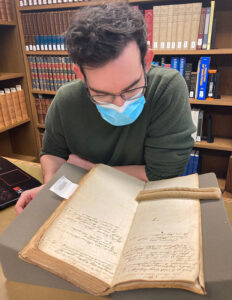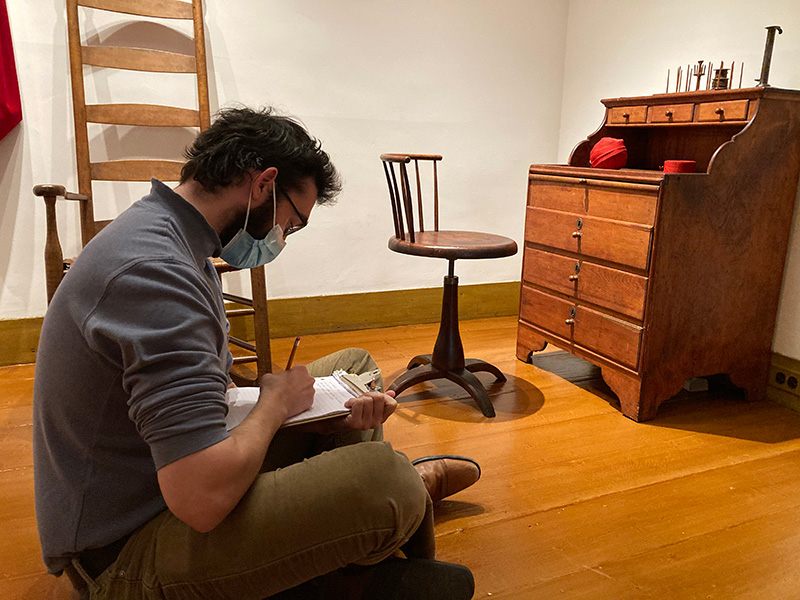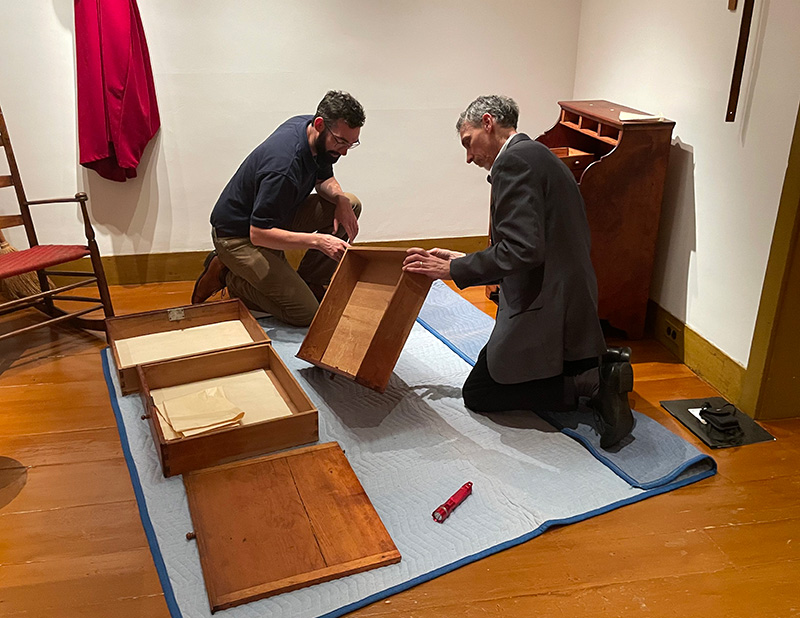The Maker’s Eye: Journeyman Woodworker Peter Hudson‘s Winterthur Fellowship Experience
by Peter Hudson
The time that I spent as a Maker-Creator Fellow at Winterthur Museum, Garden and Library, generously sponsored by the Decorative Arts Trust, has had a profound effect on my outlook and on the next steps I want to take in my career.
 When I applied to the fellowship, I aimed to experiment with how my skills and experience as a historic woodworker could contribute to and expand furniture scholarship. The seven years I have spent at Colonial Williamsburg reproducing 18th-century furniture with period-appropriate tools is a relatively unique experience, and I wanted to discover what insights someone well-acquainted with hand tools could offer.
When I applied to the fellowship, I aimed to experiment with how my skills and experience as a historic woodworker could contribute to and expand furniture scholarship. The seven years I have spent at Colonial Williamsburg reproducing 18th-century furniture with period-appropriate tools is a relatively unique experience, and I wanted to discover what insights someone well-acquainted with hand tools could offer.
The staff at Winterthur, particularly Jackie Killian, Elizabeth Palms, Brock Jobe, Josh Lane, and Greg Landry, provided me with unparalleled access and support that allowed me to deeply engage with the furniture in the museum’s collection. Through spending time sitting with individual objects, taking measurements, and talking through my observations, I developed the technique of the “Maker’s Eye,” which I see as a way to frame my discoveries using a particular knowledge base.
The Maker’s Eye is a skill-set that is different from those of a curator. Cabinetmakers develop a unique perspective from spending days working with materials and thinking about what they can and cannot do, using historic tools that possess specific strengths and weaknesses, and troubleshooting when things go wrong. Each of these factors allow me to look at a piece of furniture and, in a way, put myself at the bench of the craftsperson who made the object. A maker’s world is a tactile one, no matter the century. This tactile connection provides an intimate understanding of the processes and materials that shaped each piece. As I examined the marks left behind by the builder’s tools and process, I was able to use the Maker’s Eye approach to flesh out at least part of the story of the artisan behind the workbench.
The object that received the most attention was a Shaker work desk (1962.0504). The lovely piece was built in the first half of the 19th century at the Sabbathday Lake community in southern Maine. I observed and documented the evidence left behind—the mismatched dovetails, errant layout lines, and the telltale scratch of a chipped blade—and built a body of evidence to make the case that the desk was made in conversation between a master and an apprentice. By engaging with the object from the perspective of the maker, I was able to see their thought process. For example, the mismatched dovetails could indicate that the maker either learned their trade outside of a traditional apprenticeship or that they were working on the dovetailed drawers while their teacher had their back turned. As someone who has made a lot of dovetails, it is far easier to just re-use the same layout on each drawer than it is to lay them out over and over again. In the same vein, learning when to stop and sharpen your tools is an essential part of woodworking. The goal is to always be working the tool, not letting the tool work you, which a dull blade all but guarantees. On the desk, I read the marks left by a chipped blade as a sign that our maker hadn’t yet learned when to stop and sharpen a dull tool.
As I move forward in my career as a journeyman joiner, I would like to continue to develop the Maker’s Eye alongside my understanding of Maine furniture. I am also seriously considering a master’s degree in furniture conservation, something I wouldn’t have contemplated had I not spent time at Winterthur and with Greg Landry in particular. My time at Winterthur not only opened doors, but revealed doors I hadn’t even known were accessible.
Peter Hudson was the Maker-Creator Fellow at the Winterthur Museum, Library and Garden in the spring of 2023. The Decorative Arts Trust underwrote his fellowship as part of the Emerging Scholars Program.
About The Decorative Arts Trust Bulletin
Formerly known as the "blog,” the Bulletin features new research and scholarship, travelogues, book reviews, and museum and gallery exhibitions. The Bulletin complements The Magazine of the Decorative Arts Trust, our biannual members publication.
Click Images to Enlarge
Did you know that clicking on the images in Bulletin posts will allow you to get a closer look? Simply click on an image, and a larger version will open in a pop-up window.









